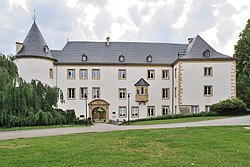This article has multiple issues. Please help improve it or discuss these issues on the talk page . (Learn how and when to remove these messages)
|
 | |
| Purpose | European integration studies Digital humanities |
|---|---|
| Location |
|
| Coordinates | 49°32′35.4″N5°55′35.0″E / 49.543167°N 5.926389°E |
| Website | www |
The Centre Virtuel de la Connaissance sur l'Europe (French for "Virtual Centre for Knowledge on Europe "; abbreviated CVCE) is an interdisciplinary research and documentation centre dedicated to European integration studies. It is a public corporation founded by law on 7 August 2002.
Contents
It develops a digital library of multimedia resources related to European unification efforts since World War II, including the development of related international bodies such as the European Union. [1] The library is available in English and French; some documents are available in other languages. On 1 July 2016, the CVCE was integrated into the University of Luxembourg, and the Centre for Contemporary and Digital History (C²DH) has taken on the task of maintaining and developing the CVCE.eu website.
The digital library was formerly named the European NAvigator (ENA).
The large multimedia knowledge base includes original texts (treaties, etc.), video and audio clips, press articles, photos, interactive maps, cartoons and tables.